Enkianthus perulatus, with almost all flowers fallen. Grown only for the brilliant Fall foliage. Out by the bird feeder.
Mazus repens 'Alba', repens meaning 'to creep'. A very low groundcover that is beautifully evergreen and usually a purple-pink colored flower. But I find it must not be allowed to be in very dry soil, and ours, here, is naturally sandy. This yard wide area is at one end of the lens shaped bed featuring Red Knockout Roses, just outside the bank of windows in the addition. It was more widespread, but drought took a lot out.
Kerria japonica 'Plena' again.
Not sure what this white flowered plant is. Years ago I planted seed of both the normal, purple-pink for of the old fashioned cottage garden plant called Dame's Rocket. This may be the white flowered sort, and I would much rather, if either have survived, I have the white. I think it was a little to vigorous for my small perennial area, and it may have seeded, somehow, along the path that leads to the barn, now toolshed. Cottage garden plants intrigue me, as the rich were fascinated with plants from the age of British exploration, and had the poorer locals plant and maintain their grand gardens. The poorer would take seed or plants to their own humble gardens, in front of their cottages, and so the tradition and name came about.
Not the white flowered form of Lunaria biennis, although close, in my opinion.
Another cottage garden plant you may alway have, once you plant it. Have not seen the white form I once planted as seed, but this, which might have come as a hitch hiker with wanted plants from someone else's garden, is always here. Lunaria biennis, superstitiously said to bring wealth, is called the Money Plant. The seed capsules reminded people of silver dollars, I suppose. Since it grows for a year, winters and then blooms, I am surprised I have it every year in flower. Some seed must have gone unsprouted for a year. A mystery.
One of the two brilliant Flowering Quinces with Japanese names here. Did not bother to save either name. This one grew huge and I will continue to cut it back, as it is on one side of the little rock garden and would soon shade wanted plants out. The other is stunted, never having been moved from the pot it was in when purchased.
Another photo of the white flowered sort of the Bleeding Heart.
An extremely large Viburnum, and this one smells exactly like Johnson's Baby Powder. Perhaps V. carlesi?
The two little planters with Semperviviums on the apron of what was the garage have gone through a Summer and now a Winter never moved from this one spot, and look very nice. New growth has covered much of what looks dead. As I have said so many times, like living sculpture.
Took an earlier photo of the planter by the little pond, not knowing it would look even better. If this is Myotis palustris, which species name relates to swampy areas, I may put seed, that comes, among the rocks that edge the pond. Already, among the moss, some Violets have seeded there.
One of the Spring bulbs that comes along quite late, this is the relative of the famous Bluebell of English woodlands. That one is called Scilla non-scripta, I think. This is Scilla hispanica and comes in this blue-violet, as well as the less common white or orchid pink. All three were planted. Only the 'blue' is increasing here. I find only a few of the others still around.
A rather malformed Flowering Quince with an unrecorded Japanese name. Behind the pool deck in the rehab, propagation area, with hopes it will look better in the future.
Shown again, here, Flowering Quince 'Cameo'.
Another white flowered Bleeding Heart. They are thriving here.
And this shrub is not. It is the neat, underused evergreen Barberry called 'William Penn'. I really should move it to a place with more Sun. May take a nap, instead.
And neither is this plant thriving. The only dwarf German Iris still showing up, out of a collection planted in the rock garden over 20 years ago. And a fine blue. But growing out of a Cotoneaster planted much more recently.
Where is my gardening crew, when I need them?
The white and normal colored forms of Viola odorata are all over, and much appreciated.
The Japanese Painted Fern, Athyrium japonica pictum, if I have that right, is all over, also. One plant was at the base of the screened porch, but spores have sprouted and a good group is developing. Showing some interesting genetic diversity in look.
Why I say, all the time, that this vine, Akebia quinata, is something of a menace. I will get out the pruner and get it under better control, but don't turn your back on it.
Another of the Kerria japonica 'Plena' on the property.
The Fothergilla 'Mt. Aerie' in the circle the drive encloses.
Frustrated plans that seem to have worked out nicely. A line of Scilla hispanica was put between the Azaleas and the walk. Generally a fail. But those bulbs grew, bloomed, seeded, and the seeds have grown and many are blooming now among the stepping stones of the front walk. Don't see a single white bloomed clump yet, but some pink and some the typical blue-violet of the wild plant.
Surprised to see some more of the only sort of dwarf German Iris still surviving in the little rock garden. A blue-violet.
A famous southern vine, Gelsemia sempervirens, I think, the 'Confederate Jasmine' has climbed above the lattice fence behind the little rock garden and is blooming its yellow. I like the scent. The blue circle is from my youngest grandson. Above it is a house of Jersey Cedar that is meant for a House Wren. No takers in many years, but the entrance hole is shaped to make bring twigs in easier. The little perch fell out as the wood shrank. I will put another in in my spare time.
This Viburnum 'Popcorn' brings more comment than any other plant on the property, but the yellow Kerria japonica 'plena' draws positive comments also.
In the shrub border that hides a screen that hides the potting bench, is
a Shadbush, Shadblow, Amelanchier stolonifera.
A larger Fothergilla major 'Mt Aerie' blooms near the screened porch.
Epimedium sufureum is not only a fine bloomer, briefly, in the Spring, but a beautiful groundcover that wins out over most weeds. And it is rather evergreen and only requires string trimming down, when it looks ratty in February. Most Epimediums are like that, and usually rather high priced, as compared to many another perennial. I don't find them too slow growing, so why the price?
Viburnum pragense, just behind the bird feeder.
The little yellow dot on the hanging Sissle seed feeder is New Jersey's State Bird, the Goldfinch. Why so shy? Maybe caged in G. Washington's day, like the Cardinal. And not frequent here at the feeders, although their calls are constantly heard as they fly past, overhead. The yellow plastic is to help attract them, as the red is on the Hummingbird feeder.
Rhododendron 'My Jane'.
Often walk out and note a time, with Sun just right, that I should take a picture. I cannot recall planting this clump of Scilla hispanica in the main perennial bed, but it is really doing great.
This small native Iris, I. cristata, is ideal for the rock garden, being hardly more than eight inched tall, flowers included. This blue may be 'Powder Blue Giant', because the white form, called 'Tennessee White' seems to have smaller, maybe more typical blooms. A native of our southern mountains, I think.
Taken through a front window. The typical, white flowered Dogwood is scattered through these woods. I believe the double pink Azalea is called 'Celebration'.
The old pink flowered Dogwood is so tall that little is seen from inside the house. We added it, while the whites are all native.
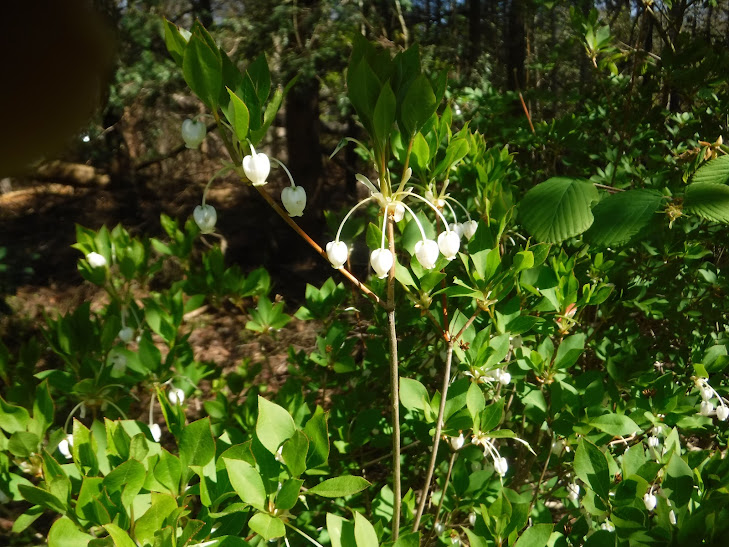
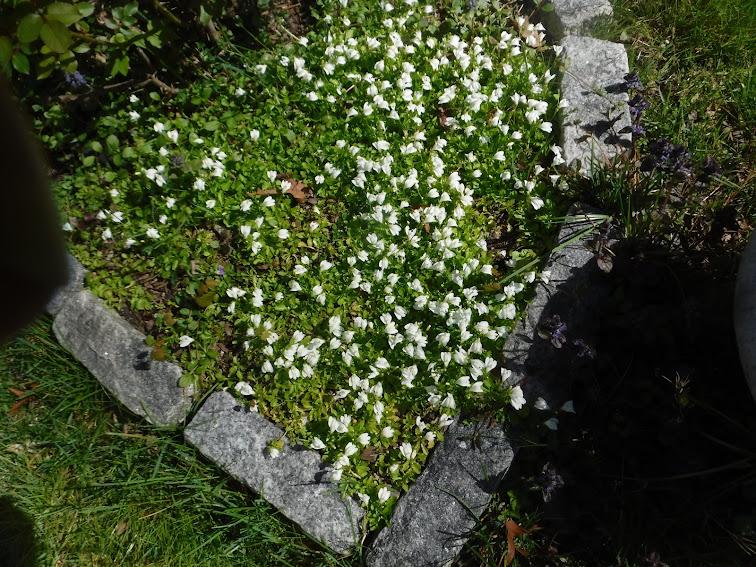








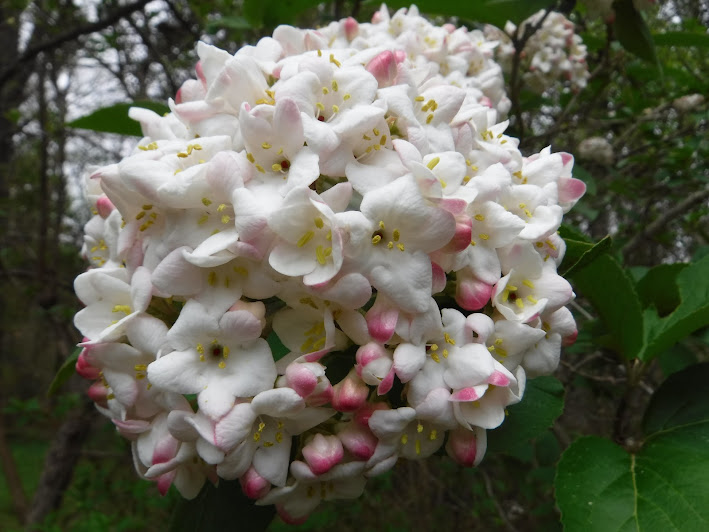




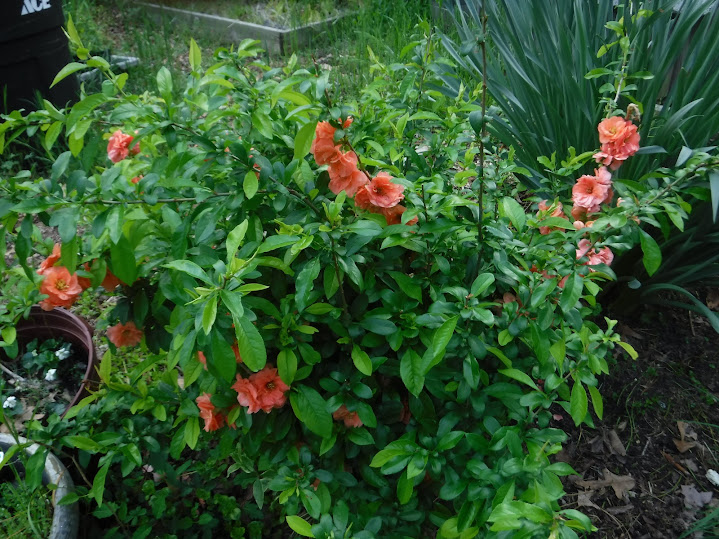

















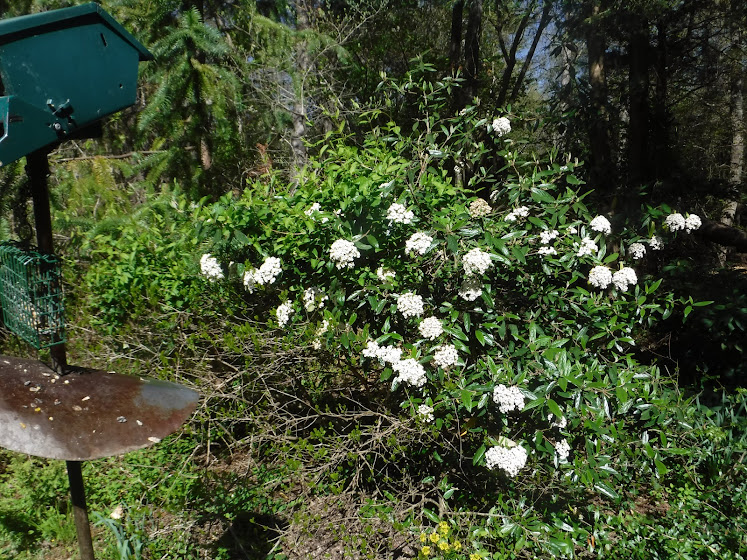



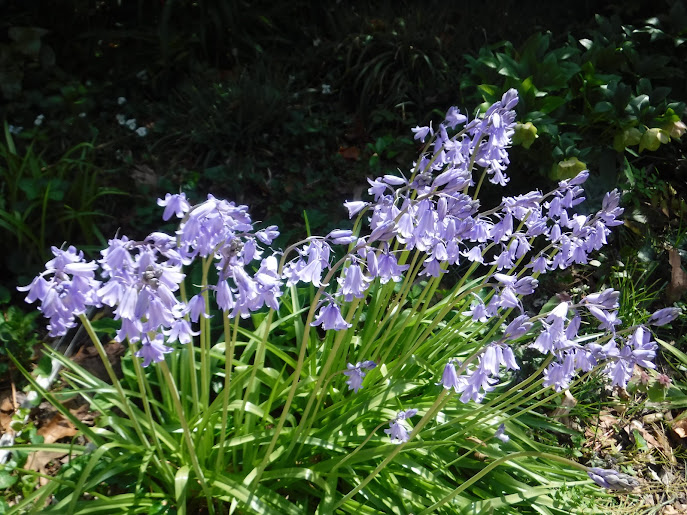






What a pretty iris.
ReplyDelete